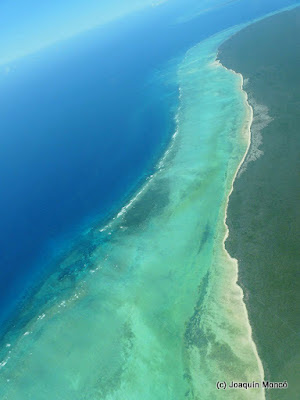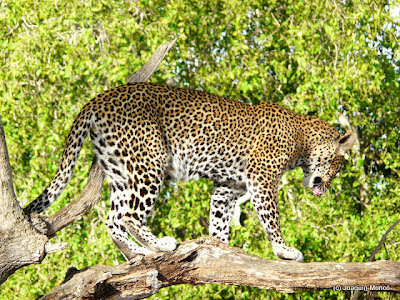El aeródromo en Moçimboa de Praia apenas era. Un breve edificio a medio construir o a medio derruir, con una torre que no alzaba gran cosa, una báscula para elefantes y nadie por los alrededores. Sólo el cielo azul de Mozambique y el sol. A resguardo de la sombra fue pasando lento el tiempo hasta que un par de empleados aparecieron con la calma que da una pista tan poco frecuentada. No había prisa. Las avionetas estaban previstas y vendrían.
Tras unos breves trámites entre risas y bromas, salimos a la pista donde debería posarse la avioneta en algún momento, aunque aún no se divisaba ningún destello en el cielo. Al poco, un rumor apagado fue tomando cuerpo, como una mosca perdida en el espacio, hasta que se transformó en un claro zumbido de gasolina, en dos alas y un motor. La avioneta aterrizó ágilmente sobre el asfalto claro y un piloto de inmaculada camisa blanca nos saludó en inglés con acento alemán. En un instante cargamos los petates en la panza del aparato y nos atamos a los asientos pegados al cristal de la ventanilla dispuestos a no perdernos el espectáculo. Con unos brincos y botes la avioneta se alzó en el aire rumbo a la frontera tanzana. Mozambique desapareció tan pronto como comenzó y antes de darnos cuenta descendíamos al otro lado de la línea, en Mtwara, para cumplir con los obligados trámites de visados y permisos en el pasaporte. Una bolsa de anacardos de la tierra hizo la espera más sabrosa.
Dar, Zanzíbar, Selous..., destinos posibles en alas de pájaro, espejismos entre las nubes de Africa, sueños tropicales. De nuevo en el aire, el rumbo siguió hacie el norte camino de la reserva de Selous calcando la línea de la costa del Índico que se perfilaba tresmil metros por debajo de la cabina. Con un pincel colosal fue dibujando un lienzo sublime en el que la naturaleza se difuminaba en brochazos de óleo, en rastros de pintura, azul, cobalto, turquesa donde los bajíos se deshacían en la orilla; ocres, amarillos, pardos donde la tierra se volvía agua. El cuadro kilométrico se extendió hasta que la mancha verde del delta anunció la desembocadura del río Rufiji como una bandera al viento. Las aguas turbias se desperezaban lentas entre los bancales de arena portando limo y sueños profundos. Incluso me pareció discernir algunos hipopótamos solazándose en las riberas.
El lienzo volvió a hacerse Tanzania cuando la avioneta aterrizó en la pista de tierra que se abría en la sabana como una cicatriz caliente.
(Cruzando la frontera entre Mozambique y Tanzania, en agosto de 2008)
********
OIL PAINTING ON AFRICAN CANVAS (MOZAMBIQUE AND TANZANIA)
Moçimboa de Praia airport hardly was. A small half-built or half-crumbled building, with a short tower, an scale for elephants and nobody nearby. Just Mozambique blue sky and the sun. Sheltered in the shade, time was passing by slowly until a couple of employees came up with the calm that gives such an empty track. There was no hurry. The planes were planned and will come.
Moçimboa de Praia airport hardly was. A small half-built or half-crumbled building, with a short tower, an scale for elephants and nobody nearby. Just Mozambique blue sky and the sun. Sheltered in the shade, time was passing by slowly until a couple of employees came up with the calm that gives such an empty track. There was no hurry. The planes were planned and will come.
After a few formalities, laughing and joking, we went out to the track where the small plane should land at some point, although we could not see any gleam in the sky yet. Soon, a far buzzing began to take shape, like a fly lost in outer space, until it became a clear humming of gasoline, two wings and an engine. The plane landed nimbly on the pale track and a pilot in a spotless white shirt greeted us in English with German accent. In an flash we loaded the bags in the belly of the plane and fastened to the seats stuck to the window glass not to miss the show. With some bumps and leaps the small plane jumped into the air towards the Tanzanian border. Mozambique disappeared as soon as it started and suddenly we were descending across the line in Mtwara, to go through the formalities of required permits and visas on the passport. A bag of local cashews made the wait more palatable.
Dar, Zanzibar, Selous... possible destinations on bird wings, illusions amongst African clouds, tropical dreams. Back in the air, heading on north on the way to Selous reserve tracing the line of the Indian Ocean coast outlined three thousand meters below the cabin. With a colossal brush it painted on a sublime canvas where nature was blurring in oil brushstrokes, in traces of paint, blue, cobalt, turquoise where shallows dissolved on the shore; ocher, yellow, brown where the land became water. The huge picture extended until the Delta green stain announced the Rufiji River mouth like a flag flying. The muddy waters slowly stretched between the sand beds carrying slime and deep sleep. Even I saw some hippos basking on the banks.
The canvas became Tanzania again when the plane landed on the dirt track that opened in the bush like a hot scar.
(Crossing the border between Mozambique and Tanzania in August 2008)
(c) Copyright del texto y de mis fotos: Joaquín Moncó
The canvas became Tanzania again when the plane landed on the dirt track that opened in the bush like a hot scar.
(Crossing the border between Mozambique and Tanzania in August 2008)
(c) Copyright del texto y de mis fotos: Joaquín Moncó


































